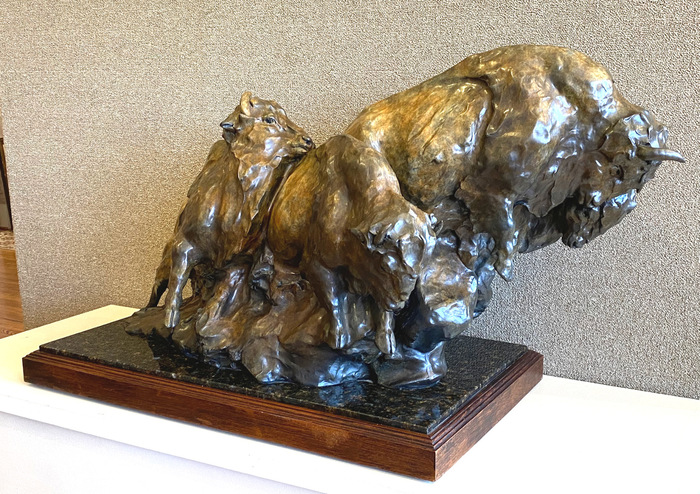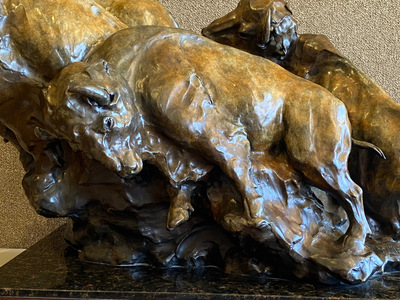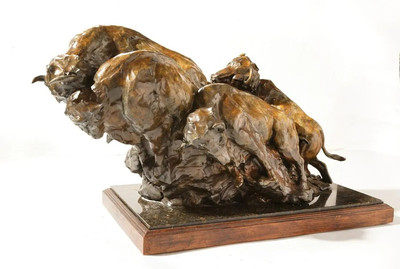Sherry Salari Sander "American Bison" Buffalo
-
- Sherry Salari Sander
- Born 1941
- Montana Artist
- Image Size: 20 x 30 x 17
- Medium: Bronze
- Dated 1987
- "American Bison" Buffalo
- Contact for Price & Info
- View All By This Artist
Details
An excellent example of ultra-impressionism in bronze.
-
Biography
Sherry Salari Sander Born 1941
Read LessSherry Salari Sander (American/Montana, b. 1941), "American Bison", 1987, bronze, signed and dated on self-base, h. 18 1/4 in., w. 38 in., d. 16 1/2 in., marble and wood base, overall h. 22 in
Sherry Salari Sander:
From Montana, Sherry Sander does wildlife sculpture, often multiple depictions, in a somewhat loose Impressionist style from her studio in a 300-acre wildlife preserve that she and her husband have created near Glacier National Park in Montana. She spends many hours observing the animals in this area that attracts eagles, otters, foxes, wood ducks, deer and bears. She also draws constantly, something she feels is essential to creating a quality piece of sculpture.Sanders travels extensively including to Alaska and Africa. In 1995, a retrospective exhibition of her work was held at the Thomas Gilcrease Museum.
She grew up in Northern California and began her art training as a potter. However, when a foundry opened near her Montana home, she changed to sculpture. She is married to Dr. Loren Vranish, who was born in Winnett, Montana, and her inspiration to create wildlife subjects came from observing antelope with him near his home. She is an accomplished horsewoman who enters competitions.
She has won numerous honors including from the North American Sculpture Exhibition, the Buffalo Bill Historical Center and the National Sculpture Society. She regards the gold medal she won from the National Cowboy Hall of Fame as a very high point in her career, being the first woman to win that honor.
Sander's heroic-size Gorilla, at the Denver Zoo and Benson Park in Loveland, was selected for the National Sculpture Society's exhibit, Masterworks of American Sculpture and Selections from the National Sculpture Society 1875-1999. She was selected by Art of the West magazine as one of "twelve living artists we feel make up America's most compelling artists, and who's work 100 years from now will have withstood the test of time and continue to stand out, just as it does today."
Her monumental sculptures can be seen at the Buffalo Bill Historical Center, the Denver Zoo, the Oklahoma Zoo, the Genesee Country Museum, the National Wildlife Art Museum and the High Desert Museum.
Source:
Art of the West Magazine, November/December 2003
Sherry Salari Sander spends much of her time studying animals in their natural habitat ranging from the Yukon to the African bush. Much of her inspiration comes from the Montana countryside and small wildlife preserve and wildlife sanctuary, which is the setting for her home and studio.A renowned sculptor, she has long been devoted to animals and their co-existence with the outdoors. As a child growing up in northern California and encouraged by her mother, Sander has had "pets" ranging from dogs and cats to horses and gerbils. That early acquaintance with animals left an indelible impression - one that can easily be seen in her work.
Critics cite her for her ability to capture the magic of the animal's spirit through its movements as well as expressions. "Inform Art" said of her work, "What remains hidden (unformed) is up to the viewer to complete. Emerging subjects left in a loosed, abstract style are Sander's trademark."
Sander's bronze pieces, done in greens, grays, and tawny hues, reveal a desire for experimentation and creativity. She says, "I wanted to see if I could develop a color in my patinas. Light reflects differently on small and large complementary planes, allowing the sculptor to use those contrasts through patination, thereby emphasizing form and composition."
Art of the West magazine has praised her work for its delicate detail of balance and imagination. Technique has to be balanced by authenticity, so Sander travels extensively to observe her subjects, including trips to Africa, Alaska, Spain, and Italy as well as throughout the United States.
In an article for Art Today, Sander said, "The creative process evolves from such pilgrimages. "She was honored with a major retrospective exhibition at Gilcrease Museum, Tulsa, Oklahoma in 1995.
Sander is a member of the Society of Animal Artists, National Sculpture Society, North American Sculpture Society, Artist of America, and the Allied Artists of America. She was selected to exhibit her sculpture, Gorilla, at the National Sculpture Society's exhibition at the Fleischer Museum, "Master Works of American Sculpture and Selections from the NSS, 1875-1999," from October 20, 1999, through May 1, 2000.From Whistle Pik
Her work has been exhibited at the National Academy of Design, the Buffalo Bill Historical Center, the Denver Zoo, Oklahoma City Zoo, Benson Park Sculpture Garden, Genesee Country Museum, the National Museum of Wildlife Art, Huntley Lodge, Big Sky Resort, Gerald Ford Amphitheater, in Vail, Colorado, High Desert Museum, in Bend, Oregon, and the Leigh Yawkey Woodson Art Museum.
"Even as a child, adapting a way of life to an environment had and continues to inspire many of the sculptures I design today. As little girls, my sister and I created make-believe houses out of cardboard and salvaged wood from a nearby lumber yard. Beyond our "town" were holes for rabbits, corrals for horses, and deer hiding in the woods. We used the limitless, pure fantasies only a child can truly experience. As an adult, I am trying hard to hold onto that period of time when creativity was at its richest. I am concerned by the pace that is being set for the next generation of youngsters where there is not space in the day set aside for fanciful play. I feel I would not be an artist today if my mother had not given me the time and opportunity to build my own make-believe worlds.Q. What can you share about your creative process?
A. I view the creative process as a sculpture in itself. Learning to see is the foundation and is the hardest to learn. It requires patience as the retina and cortex don't always cooperate. In my discipline it has taken many years loving nature, watching and remembering. The evolution of an idea in its infancy is faintly structured. A great deal of drawing is essential to imprinting the subjects of which I will be sculpting. I rarely draw the actual composition before I begin the piece, thereby allowing the mental image to develop on its own.
Regardless of the nature of the subject matter, a certain amount of deference is due the timeless elements of design which are balance, continuity and contrast. Have courage, for commitment and great personal rewards await you.Q. What ideas do you have for a future human community on Mars?
A. We must acquiesce that all things, whether they be art, old or new worlds, require balance for their continuance. In our technically accelerating society, I am fearful that the arts are losing that symmetry and will no longer be able to enjoy the respect they have earned through time. The establishment of a new society on Mars and beyond, without sculpture, painting, music or mimicry, will have invocatory images of an ineffable and sterile people. Are we earthlings on the evanescent edge of such a world, where today the arts are barely holding a position of credibility in our educational system? Perhaps, when future generations inhabit far away planets, all they'll need is a little cardboard, lumber and crayons, and art will take care of itself.


